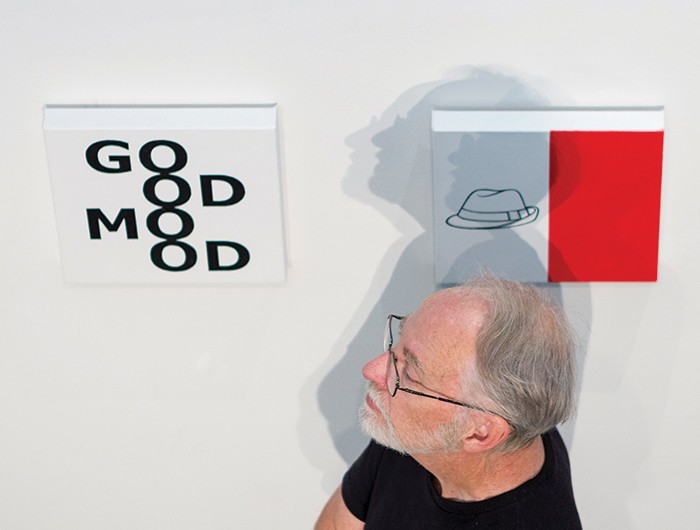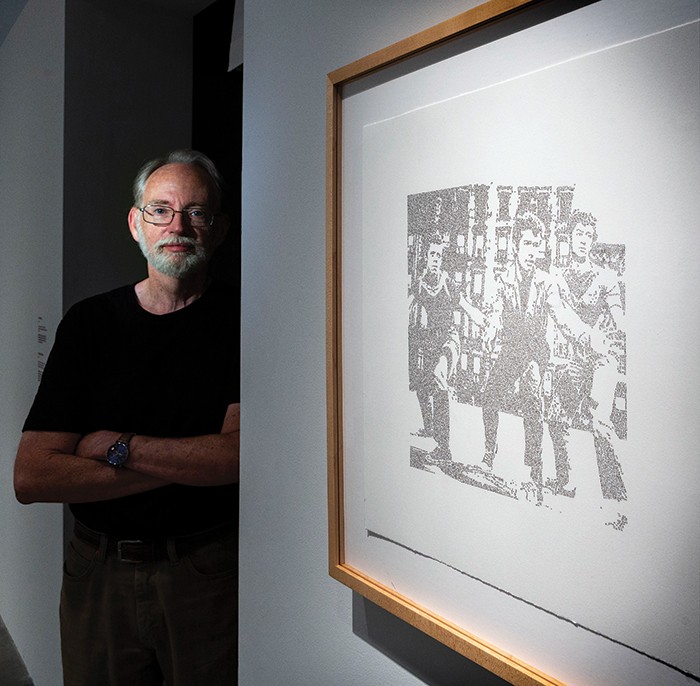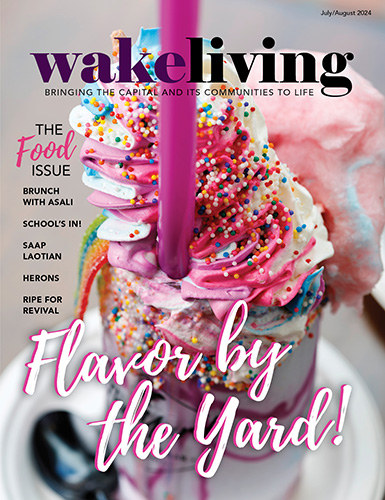Glance at Michael Klauke’s “In Good Faith,” and it appears to be a line drawing of Botticelli’s beautiful “Cestello Annunciation” — depicting Gabriel’s revelation of the coming Christ child to Mary, who responded: Yes, may it be done.
But look closer.
Those lines actually are tiny words, and the words are ugly — taken from legal memos to President George W. Bush in 2002 on ways to justify torture. Yes, it may be done.
That kind of irony appeals to Klauke, a Cary visual artist who’s also in love with words and the sundry ways they can be used, interpreted and manipulated. He’s fascinated by the contradictions that accompany a phrase such as “in good faith.”
So, his signature style is a fusion of his passions. It’s called textual pointillism — the creation of images from thousands of tiny, handwritten words on paper.
Their union was born in trauma.
“When the 9/11 attacks occurred, a local gallery asked several artists around town to do what they called a reaction to the event, and I really wanted to do something positive,” Klauke recalled. “I did a drawing called ‘Beyond Words,’ with the word ‘GOD’ in big block letters. The G was the word ‘Judaism’ written hundreds of times, the O was ‘Christianity’ and the D said ‘Islam.’ I was trying to do something that would bring people together.
“I looked at it, and I thought, ‘Wow! If I can make a big word out of a bunch of little words, maybe I can make images out of a bunch of little words.’”
That idea has made Klauke’s mark on the art world. Many of its fruits were on display this summer at CAM Raleigh in a three-month exhibition called “In So Many Words.”
There’s Malcolm X, rendered from the opening dictionary entries for every letter from A through X — inspired by Malcolm’s account of hand-copying the dictionary in prison. There’s NRA leader Wayne LaPierre (made up of names and brief profiles of victims of mass shootings — and unfinished, as were their lives, on the right margin). There’s Barack Obama (from American writings and speeches, mostly aspirational). There’s a pre-inauguration Donald Trump (in a work called “A Man is as Good as His Word,” using his tweets that demeaned others). There’s a scene from “West Side Story,” rendered from “Hamilton” lyrics.
Wait. “West Side Story” and “Hamilton”? (Think immigration if you want. Or think white people portraying people of color, and then the reverse. It’s up to you, Klauke says.)
The open interpretation appeals to Gab Smith, CAM Raleigh’s executive director.
Viewers appreciate Klauke’s work “first as a visual piece of art,” Smith said, “and the more they look at it or the more they want to understand, there are these other wonderful layers in the work. Sort of the ‘why’ around it.”
“I pick people or subjects that I find interesting,” Klauke said, “usually for positive reasons.” (There are exceptions. Trump and LaPierre are not among his heroes.)
As for selecting the text, “in a lot of ways it’s intuitive,” he said. “Just something that jumps out at me or catches my imagination. Usually I want it to relate to the subject, but in some, I want it to be counter to the image.”
Reaction to the Trump portrait, he says, was fascinating. He entered it in an exhibition at Lake City, S.C., and braced himself.
“Everybody who saw it was a Trump supporter — and loved it,” he recalled. “They don’t see his words as horrible things. It’s just him fighting back.”

Michael Klauke’s work was on display this summer at CAM Raleigh in an exhibit called “In So Many Words.”
Inspiration and passion
Klauke’s favorite among his works is a portrait of his son, Jackson, at age 9. The text comes from children’s books and “Harry Potter”.
It captured a special moment, Klauke says, when he was “starting to realize that he was growing up, that he wasn’t going to be 9 for very long.
“I tend to be very sentimental,” he said.
Klauke, who’s 61, grew up in North Palm Beach, Fla., has an art degree from UNC-Chapel Hill and has lived in Cary since 2005 with his wife, Laura, and Jackson. He works in the registration department at the N.C. Museum of Art, where he has been for more than three decades.
And he’s finding new ways to play with words. He’s finishing an experimental book that turns Homer’s “Iliad” into an absurd but recognizable story by running it through iterations of Google Translate.
Another passion is music — rock (with an affinity for the Buzzcocks), classical and jazz. He admires several other visual artists — Jasper Johns, who was an early inspiration (his works were a “lightning bolt,” Klauke says), and Ed Ruscha, who is also inspired by language.
Always, it’s about creativity — and interpretation.
“People who are good at business or making money don’t really interest me,” he said, laughing. “I’m much more interested in people that reach down into themselves and pull up something that’s interesting that nobody has done before.”
A room of his own
He does much of his thinking on long walks, while the creating — the two months or so of decision, design and a cramping right hand — happens at home. But the household doesn’t contain the scattered debris of his active imagination. “Michael is very well organized,” Laura Klauke said. His studio is a room — and it’s private.
For Christmas about a dozen years ago, she and Jackson went to Home Depot and decided that “we had to buy those letters, like you put on a mailbox, the reflective letters,” she said. Jackson spelled out “My Special Room” on the door of his dad’s studio, “and then we had to gift-wrap the door.”
Words — as a holiday present. They’re still there.
And yes, Michael Klauke sees varied meanings in nearly everything. “You know the sign that says ‘SLOW CHILDREN PLAYING’?” his wife asked. “Most people read that, “Slow! Children playing.”
Michael Klauke sees slow children. And they’re playing.
More about Michael Klauke and his work is at michaelklauke.com.
- Take a Bough
- Discover Hillcrest
- Going Through a Phrase
- A Cut Above
- Dive into Adventure at the Greensboro Science Center
- Nonprofit Spotlight: Team Drea
- Worth the Drive: On the Square in Tarboro
- Key Lime Gose from Durty Bull Brewing Company
- Port Cask Finished Virginia-Highland Whisky from the Virginia Distillery Co.
- Home Tour: Light and Bright
- Small Business Spotlight: City Garden Design
- Garden Adventurer: It’s Tatarian Aster Time!
- From the Editor: October 2019







wonderful article about Mike Klauke. I’ve known him for years and you captured “him”. His work is very special and powerful. I find I get caught up in wanting to read the painting’s words. Exhausting to say the least,